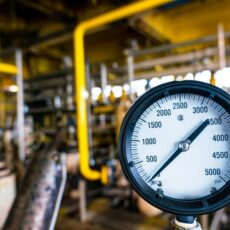 Hydraulic systems are widely used in various industries, from manufacturing to construction. These systems rely on fluid power to generate, control, and transmit energy. Monitoring and maintaining the pressure within these systems is crucial for their efficient and safe operation. In this blog post, we will explore the importance of hydraulic pressure gauges and how they enable us to monitor fluid power with precision.
Hydraulic systems are widely used in various industries, from manufacturing to construction. These systems rely on fluid power to generate, control, and transmit energy. Monitoring and maintaining the pressure within these systems is crucial for their efficient and safe operation. In this blog post, we will explore the importance of hydraulic pressure gauges and how they enable us to monitor fluid power with precision.
1. The Basics of Hydraulic Pressure Gauges:
Hydraulic pressure gauges are instruments designed to measure the pressure within a hydraulic system. They typically consist of a dial or digital display and a sensing element that converts the fluid pressure into mechanical motion. Common types of sensing elements include Bourdon tubes, diaphragms, and pressure transducers. The pressure measurements are usually displayed in units of pressure, such as PSI (pound per square inch) or bar.
2. Importance of Monitoring Hydraulic Pressure:
Monitoring hydraulic pressure is crucial for several reasons. Firstly, it helps ensure the efficient operation of hydraulic systems. By monitoring pressure levels, operators can identify any deviations from the desired pressure range, which may indicate leaks, blockages, or other issues that could impact system performance. Additionally, monitoring pressure allows for timely maintenance and adjustments, preventing costly breakdowns and downtime.
Furthermore, monitoring hydraulic pressure is essential for safety purposes. High pressure can pose a significant risk to both equipment and personnel. By using pressure gauges, operators can identify and rectify any pressure spikes or excessive pressure that could lead to system failures or accidents.
3. Types of Hydraulic Pressure Gauges:
There are various types of hydraulic pressure gauges available, each with its own advantages and applications. Some common types include:
– Bourdon Tube Gauges: Bourdon tube gauges use a curved metal tube that is in a fixed position at one end and connected to the fluid on the other end. The pressure causes the tube to straighten, which is then translated into a reading on the gauge. Bourdon tube gauges are durable, accurate, and suitable for a wide range of applications.
– Diaphragm Gauges: Diaphragm gauges use a flexible diaphragm that bends in response to the fluid pressure. The displacement of the diaphragm is measured and displayed on the gauge. Diaphragm gauges are suitable for measuring low-pressure ranges and are commonly used in applications such as HVAC systems and low-pressure hydraulic systems.
– Digital Pressure Gauges: Digital pressure gauges provide a digital display of the pressure reading. They often have additional features such as peak pressure memory, programmable alarms, and data logging capabilities. Digital gauges are versatile, easy to read, and offer high accuracy.
4. Considerations for Selecting Hydraulic Pressure Gauges:
When selecting hydraulic pressure gauges, several factors should be taken into account, including:
– Pressure Range: Choose a gauge that can measure within the expected pressure range of your hydraulic system. It is also essential to consider the maximum pressure spikes that may occur.
– Accuracy: Look for gauges with high accuracy and repeatability to ensure precise measurements.
– Environmental Conditions: Consider the operating environment, such as temperature, humidity, and presence of corrosive substances. Select gauges that are designed to withstand these conditions.
– Mounting Options: Different gauges offer various mounting options, such as panel mount, surface mount, or direct mount. Choose the appropriate mounting option based on your specific needs and space constraints.
5. Maintenance and Calibration:
Regular maintenance and calibration of hydraulic pressure gauges are vital to ensure their accuracy and reliability. Over time, gauges may drift or become less accurate due to factors like wear and dirt accumulation. It is recommended to follow manufacturer guidelines for maintenance and calibration intervals. Regular calibration ensures that the gauge provides accurate readings, allowing for precise monitoring and control of hydraulic systems.
Conclusion:
Hydraulic pressure gauges play a crucial role in monitoring and maintaining fluid power in hydraulic systems. By providing accurate and precise pressure readings, these gauges enable operators to identify potential issues, ensure system efficiency, and promote safety. When selecting gauges, consider factors such as pressure range, accuracy, environmental conditions, and mounting options. Remember to perform regular maintenance and calibration to ensure the ongoing accuracy of the gauges. By understanding and utilizing hydraulic pressure gauges effectively, industries can harness the power of fluid systems with precision and confidence.

